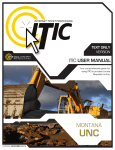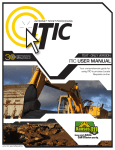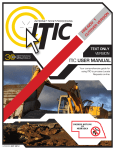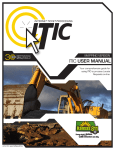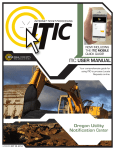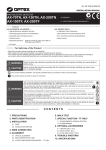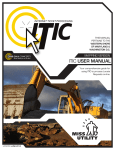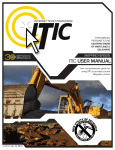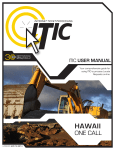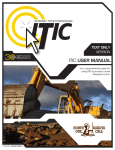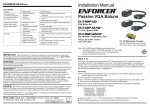Download ITIC USER MANUAL
Transcript
ITIC USER MANUAL Your comprehensive guide for using ITIC to process Locate Requests on-line. SM UPDATED JULY 26 2012 INTRODUCTION WELCOME, USER! Welcome to ITIC! You will find a comprehensive step-by-step guide for processing your locate requests online in the following pages. We have included a detailed description of the innovative tools and features that have been added to this newly revised version of ITIC. We have designed this manual to provide the knowledge required for the efficient submission of accurate ITIC locate requests. We’ve packed a lot of information into these pages, and have arranged it in a streamlined, user-friendly format. It is loaded with visual examples and helpful hints. We think it is best to read it from beginning to end before you start, but the design also facilitates quick references to specific subject matter. So, what are you waiting for? Let’s get started! And remember, our skilled staff is here to help. Assistance is available through the Help Desk at (563) 884-7762. *An important word from the editor: This document contains many color drawings, actual screenshots, and color-coded information. For best results, we recommend that this document be printed in COLOR 01 TABLE OF CONTENTS INTRODUCTION01 TABLE OF CONTENTS02 COMING SOON: LIVE CHAT03 SUBMIT A LOCATE REQUEST READY04 GET SET05 GO05 ITIC USER INFORMATION06 EXCAVATOR INFORMATION06 STEP 1: Onsite Contact Information07 STEP 2: Excavation Information 07 - 08 PROFILES09 - 10 STEP 3: Location Information 11 - 17 STEP 4: MAP IT THE MAP 18 - 19 FINDING THE CORRECT LOCATION ON THE MAP20 - 24 GRIDS 25 - 26 STEP 5: START DATE INFORMATION27 STEP 6: UTILITY NOTIFICATION LIST/SUBMITTING LOCATE REQUEST 28 POST - SUBMITTING A LOCATE REQUEST VIEW A TICKET29 HELP PAGES/APPENDIX APPROVED ABBREVIATION LISTA1 DISTANCES AND MEASUREMENTSA2 WORK OFF PROPERTY AND ROADS - EXAMPLE A3 SEPARATING LARGE WORK AREAS - EXAMPLE A4 02 LIVE CHAT 03 COMING SOON: ITIC LIVE HELP! ITIC Live Help is an interactive chat program created to assist ITIC users in real time. It allows users to directly contact an ITIC specialist while they are using the ITIC program. ITIC Live Help is currently unavailable in Iowa. It will be made available in the near future. SM COMING SOON! COMING SOON! COMI LOGGING IN TO ITIC READY Click on “Enter a new ITIC ticket online” button found on the left side of the Iowa One Call Homepage (www.iowaonecall.com). You will be re-directed to the IA One Call ITIC Login Page. Enter your email address and password then click “Login.” If you have forgotten your password, click “Forget your Password?” and we will email it to you. FYI By logging in, you agree to the Terms and Conditions. You can read the full text by clicking the “Terms and Conditions” link. 04 SUBMIT A LOCATE REQUEST 05 The ITIC Main Menu appears upon login. GET SET In this section you will learn to prepare ROUTINE locate requests. GO! Click “Submit a Mark Out Request” Each field has a pop-up help box listing the field definition/requirement. Activate pop-ups by clicking on the field titles. FYI The ITIC system will not allow you to enter special characters such as * \ ~ ‘ or “. % SUBMIT A LOCATE REQUEST 06 ITIC USER INFORMATION Phone Number and Ext. These fields will auto-fill with the information associated with your login. Click the ‘Main Menu’ icon at the top of the page, then click the “Edit Account” button to update your main phone number. User Name Enter YOUR first and last name as the ITIC user entering the information. EXCAVATOR INFORMATION This section will auto-fill with your company information. To update your company information, click the ‘Main Menu’ icon at the top of the page, then click the “Edit Account” button to make changes. FYI IMPORTANT! Do not use the ‘BACK’ or ‘FORWARD’ buttons of your web browser (Internet Explorer, Firefox, Safari, etc...). Any information already entered will be DELETED. Please use the buttons at the bottom of the form. SUBMIT A LOCATE REQUEST 07 STEP 1: On-Site Contact Information Alternate Contact and Alternate Phone Enter the name and cell phone number of another person involved with the excavation. If there is an on-site contact, enter their name here. Use a specific person’s name; dispatch, operator, anyone or unknown are not acceptable entries. [The utilities will contact this person if additional information about the site is needed.] If there is no alternate contact, re-enter your information here. NOTE: See PROFILES section (page 09) to auto-fill your routinely used information STEP 2: Excavation Information Type of Work Enter the specific type of work to be performed. Field locators need to know the specific reason for excavation rather than the work method. Do not use the words ‘Emergency’ or ‘Dig’. Examples: Install Sign, Install Secondary Electric, Repair Gas Service... FYI Use keyword searches! Type keywords (install, main, water, etc.) to generate a list of options. Make a selection from the dropdown list whenever possible SUBMIT A LOCATE REQUEST 08 STEP 2: Excavation Information - Continued... Working For Company Enter the name of the person, company, or organization the work is being done for. Is Job White Lined? Select “Y” if you have marked out the proposed area of excavation with white paint, stakes or flags. If not, select “N” Duration Enter the amount of time anticipated to complete the excavation. Use the drop-down menu to select hour(s), day(s), week(s), or month(s). Blasting, Trenching, Boring, Plowing, Backhoe, Other These ‘yes or no’ questions relate to your method of excavation. Please select “Y” for all that apply, and “N” for any that do not apply. Any excavation method that does not fall into one of the first 5 categories should be considered “Other.” You must select “Y” for at least one of these questions before you can proceed. FYI IMPORTANT! Do not use the ‘BACK’ or ‘FORWARD’ buttons of your web browser (Internet Explorer, Firefox, Safari, etc...). Any information already entered will be DELETED. Please use the buttons at the bottom of the form. PROFILES PROFILES Profiles are used to auto-fill specific fields with your routinely used information. Utilizing the ‘Profiles’ feature will enable ITIC to ‘remember’ your information saving you time in the Locate Request process. Profiles are located at the top of the second page of the locate request form. Create Job Profile Click the profile drop-down and select CREATE JOB PROFILE to create a profile. Create a name or title for the profile. The title will appear in the profile drop-down menu for selection. You can create profiles for a specific foreman/contact, or type of work which may always include the same method of excavation, customer, etc... You can also create profiles for specific counties or cities that you work in, or even save marking instructions that are commonly used. ALL FIELDS ARE OPTIONAL Click SUBMIT when complete. 09 PROFILES PROFILES - Continued The title of the profile will appear in the drop-down menu once you have submitted it. The new profile can now be used when preparing a locate request. The fields on the locate request form will auto-fill with the information you entered for that specific profile when you choose it from the drop-down list. Edit & Delete To edit or delete an existing profile, select EDIT JOB PROFILE from the “Profiles” drop-down. Edit Add or change any information as needed. Remember - All fields are optional Submit Click SUBMIT to save changes/additions Delete Click DELETE to delete the selected profile 10 SUBMIT A LOCATE REQUEST STEP 3: Location Information City County Choose the county in which all of the work will take place. Complete a separate ticket if the work extends into another county. Select the city or township where the work is taking place using the drop-down menu. NOTE: If you are working outside city limits, you must enter the name of the township where the worksite is located. Address (SINGLE Address) Enter the number of the address where the work will take place. Lot, building, PO box or rural route numbers are not addresses and should not be used. If there is no physical address, enter a “0” in the address field. Address (MULTIPLE Addresses) If work is taking place at multiple addresses, or along a street or easement from one address to another, enter a ‘0’ in the address field, and list the addresses in the Marking Instructions field. 11 SUBMIT A LOCATE REQUEST STEP 3: Location Information - Continued Dig Street Enter the street name associated with the address. If there is no address, enter the name of the street in which the digging will take place on or along. (See next page for dig street variables, unnamed road, creek, railroad tracks, etc.) Nearest Intersecting Street Enter the name of the intersecting street closest to where the work will take place. The closest intersecting street may not necessarily be a major intersection. Be sure to enter a street name in this field. ADDRESS TIP Use keyword searches! Start typing in the Street name (ex. ‘haw’) to generate a list of street name options. Select from the drop-down lists whenever possible but only if correct. This works for both street fields! 12 SUBMIT A LOCATE REQUEST 13 ADDRESS / LOCATION DESCRIPTION TIPS Unnamed Street Enter the appropriate description in the Dig Street field if the street does not have a “proper” name (i.e. unnamed county road, hwy 71 west bound exit ramp, alley, RR tracks). Give driving directions to the site when doing so. Format the driving directions by referring to an intersection of 2 named roads in the Marking Instructions field. For Instance: In the Marking Instructions, enter “From Elm Ave go N on Main St approx 400ft to unnamed road, go W on unnamed rd approx 350ft to vacant lot on N side of rd.” Multiple Names for Street If the street has more than one name, enter only one of the names in the appropriate street field. List any additional names (“also known as,” or “AKA”) in the Marking Instructions. For Instance: In the Marking Instructions, enter Main St / Us Hwy 14 - This information should be entered as ‘Main St aka Us Hwy 14’ Abbreviations When entering the information in the street fields you must abbreviate the street modifiers and directional information. For example: enter N Main St instead of North Main Street. The following are the ONLY accepted abbreviations for street name modifiers. Avenue – AVE Business – BUS Circle – CIR Drive – DR Highway – HWY Lane – LANE Parkway – PKWY Road – ROAD Boulevard – BLVD Expressway – EXPY Court – CT Traffic way – TFWY Interstate – I (I 70) Terrace – TER Place – PL Street – ST SUBMIT A LOCATE REQUEST STEP 3: Location Information - Continued Marking Instructions Enter marking instructions and any driving directions in this field. Below are a few things to remember when formatting your instructions. All locate requests require MARKING INSTRUCTIONS in this field. Marking instructions should be as complete and accurate as possible, so the utilities know where any excavation will be taking place. Marking instructions must describe the entire area where the excavation will take place - NOT what utilities need to be marked. IMPORTANT: Please provide driving directions from a known intersection any time the dig site does not have a numerical address or is not located at an intersection. Driving directions must include approximate distance and specific direction (N, S, E, W, NW, NE, SE, or SW). Example - “FROM MAIN ST GO N ON 1ST ST 1000FT, THEN LOCATE 20FT OUT ON W SIDE OF 1ST ST GOING N TO MONROE ST.” Work Taking Place at an Address Enter the address number in the address field, and the street associated with it in the Dig Street field. Be sure to clearly describe the entire extent of the work area. For example: - Mark entire front half of lot. - Mark 10ft radius of house. - Mark from front corners of house to rear lot line, for width of lot. FYI IMPORTANT! Please do not use ( ‘ ) or ( “ ) for feet & inches as some printers can’t print these characters. It’s best to use feet, ft., foot, and inches or in. 14 SUBMIT A LOCATE REQUEST 15 STEP 3: Location Information - Continued WORK TAKING PLACE AT MULTIPLE ADDRESSES If work is taking place at multiple addresses, or along a street or easement from one address to another, enter a ‘0’ in the address field, and list the address information in the Marking Instructions field. For example: - Mark front and both sides of properties of addresses 714 through 721 Elm St - Mark rear of properties of address 314, 316, and 318 Jones Rd, including alley - Mark front of properties of addresses 400 through 490 MacArthur St from the curb back 15ft WORK AREA LIMITATIONS There are limitations to the amount of work you are allowed to fit onto a single ticket. If you find that your work area is larger than is allowed on a single ticket, you will need to split your worksite up into multiple tickets. (see__ for more information regarding separating large work areas). Inside City Limits – Tickets for work to be done within city limits: • For a contiguous work area along a street, right-of-way, alley, or rear easement, you may file one ticket per every 1500 feet in length. Multiple signs or utility poles being placed within a 1500-foot span would qualify as a contiguous work area. • For work to be done on private property, you may file one ticket per every ten addresses within the same hundred block. Outside City Limits (In a Township) • Work to be done outside city limits must be limited to one mile per ticket for work along a road/ditch (e.g. sign/pole installation, ditch cleaning), or to one square mile per ticket for work in an open field (e.g., farm drainage tiling). Multiple addresses in a rural area may be processed on the same ticket, provided that all addresses fall within the same one-mile span of the same road. IMPORTANT! Work to be done in multiple townships or multiple counties must be limited to one township/county per ticket (Exception: work to be done along both sides of a township road). SUBMIT A LOCATE REQUEST 16 STEP 3: Location Information - Continued Work Taking Place (or Starting) At an Intersection If work begins at the intersection, no driving directions are required. Simply describe how far and in what direction(s) the work will take place. For example: - Mark 100ft radius of (above) intersection - Mark a square area 25ft n and w from NW corner of above intersection - Mark entire w rd right of way of Elm Ave going n from Main St for 250ft Be sure to clearly describe the entire extent of the work area. Work Taking Place Away From an Intersection (No Address) If work does not begin at the intersection, and is not taking place at an address, provide driving directions to the worksite from an intersection of two named roads. (This method may also be used if work is taking place at an address, but you do not have the address information). For example: - From Elm Ave go W on Main St approx 800ft to vacant lot on n side of rd. Mark entire vacant lot. - From Jones Rd go N on Oak Ave 450ft. At that point, mark entire rd right of way of Oak Ave, going further N 250ft. - From Main St go N on Elm Ave approx 500ft to unnamed rd, then go W on unnamed rd approx 250ft to white flag on N side of unnamed rd. Mark 10ft radius of white flag. Use ONLY the following approved abbreviations when formatting the location of work or driving directions. FYI Feet – FT East – E Northeast – NE Inches – IN North – N Northwest – NW Miles – MI South – S Southeast – SE Yards – YDS West – W Southwest – SW Note: Regardless of which of the method you use to describe your work area, be sure to enter the name of the rd that work is actually taking place on in the “Street Name” field. If work is taking place on an unnamed rd, list ‘unnamed rd’ in the street name field, and enter the nearest road to intersect the dig street (‘unnamed rd’) in the intersecting street field. In the last example, you would enter ‘unnamed rd’ in the Street Name field, and Elm Ave in the Closest Cross St field. SUBMIT A LOCATE REQUEST STEP 3: Location Information - Continued GPS Latitude / Longitude If you have GPS coordinates in the NAD 83 Decimal Degree format, enter them here. Otherwise, leave this field blank. This information is not required. ITIC only accepts GPS coordinates that are formatted in the NAD 83 Decimal Degrees style. If you have GPS info in another format, you cannot enter it here. However, you can manually search for the coordinates using the Lat/Long search function. This may prove useful during the mapping process. (See page 23 for more information) Section / QTR If you know the Section number for your work area, enter it here. Similarly, If you know which section quarter your worksite is in, be sure to check the appropriate box(es). If you are working outside of city limits, you must enter the section number for the worksite. 17 SUBMIT A LOCATE REQUEST 18 STEP 4: MAP IT A Brief Introduction In this section you will learn, in detail, how to use the mapping application to map out your entire area of excavation. FYI REMINDER: IA One Call members do NOT see the map. The map & polygon are used to determine which member utilities will receive the ticket. The map will automatically search by the address, intersection, or Lat/Lon provided once you have entered the required ticket information. If the location is found, it will be displayed in the center of the map. Otherwise, you may need to search manually for the correct area. Once the correct area is found, you will need to encompass the entire area of excavation by selecting grids on the map. The area you select will determine the utilities to be notified. Search Results THE MAP Requested Location This field will auto - fill the data entered from “Location Information”. If ITIC finds one or more matches for your site, the options will be listed here. Click the drop down list to view all options and select the correct location. (Not seen in Google View) *TOP PORTION of ITIC MAP Street/Address Search Lat/Lon Search Use this button to manually search for a specific address, street, intersection, and/or city. (see page 22 for more details) Use this button to manually search for Lat/Lon coordinates. Changing the information in the Street/Address Search box WILL NOT change the information FYI entered in the Location Information fields. Make changes to Location Information fields separately. SUBMIT A LOCATE REQUEST 19 STEP 4: MAP IT - THE MAP Continued View Directional Button Change the image of the map to the OCC map view (pictured), Satellite view (See page 26 for example), or Google map view. (See page 24 for example) Click the directional button in the direction you would like the map to move. [You can also “grab” and move the map by holding down the left mouse button.] Zoom ‘In’ & ‘Out’ Bar Zoom in for more detail by clicking on the plus (+) sign or by dragging the marker up on the bar. Zoom out for an increased overall view by clicking on the minus (-) sign or by dragging the marker down on the bar. [You can also zoom in and out by using the middle rolling button on your mouse when your mouse point is on the map.] Select Grids Identify Use this function to select grids on the Use this function to identify roads, map and create an excavation polygon highways, rivers, creeks, etc., on the around your dig site. map that may not show a name. The name will appear in the bottom section of the map next to “Highlight.” Zooming in on the map makes more names visible. Measure Use this function to measure the distance between points on the map. Using this tool regularly ensures proper coverage of excavation areas and confirms distances along roads. SUBMIT A LOCATE REQUEST STEP 4: MAP IT - Continued FINDING THE CORRECT LOCATION ON THE MAP Automatic Address Search If the system finds an exact match for the address provided (single address only), ITIC will zoom in and display the location in the center of the map (as shown below). Check the following to confirm the system has found the correct location: • The street name is spelled correctly. • The nearest intersecting street provided is the closest intersecting street to the jobsite. • The city currently displayed is the same as the city provided. • The Search Results drop down for multiple matching options. MAP: Automatic Address Search 20 SUBMIT A LOCATE REQUEST STEP 4: MAP IT - FINDING THE CORRECT LOCATION ON THE MAP Continued Automatic Intersection Search If there is no address or the address was not found, ITIC automatically performs an intersection search. If the intersection is found, ITIC will zoom in and display the intersection in the center of the map (As shown below). Check the following to confirm the system has found the correct location: • The street names are spelled correctly. • The nearest intersecting street provided is the closest intersecting street to the jobsite. • The city currently displayed is the same as the city provided. • The Search Results drop down for multiple matching options. MAP: Automatic Intersection Search 21 SUBMIT A LOCATE REQUEST 22 STEP 4: MAP IT - FINDING THE CORRECT LOCATION ON THE MAP Continued Manual Street/Address Search The map will center in the county listed on the ticket. Use the Street Search feature to manually search for the area. In the Street Search box, the fields default with the information entered in the Location Information. This information can be changed in order to search for different areas on the map. Changing this information does NOT change the information in the Location Information fields; it only changes your search criteria. You may enter a single street with the city, another intersection with the city, or just the city itself. If the new data entered is found, it will be centered on the map. If you are working on a street or road with “State”, “County”, or “Hwy” in the name, and it has an alternate name, use the alternate name to expedite the map search. If you have a number in the street name (hwy or county road) search only the number. Changing the information in the Street/Address Search box WILL NOT change the information FYI entered in the Location Information fields. Make changes to Location Information fields separately. SUBMIT A LOCATE REQUEST STEP 4: MAP IT - FINDING THE CORRECT LOCATION ON THE MAP Continued Search by Latitude/Longitude ITIC will automatically search accurate coordinates provided on the ticket. If you wish to do a manual Lat/Lon search click the “Lat/Lon Search” button. Enter the coordinates in the correct format. The map will center the coordinates on the screen with a point if they are found within the county you have provided. 23 SUBMIT A LOCATE REQUEST STEP 4: MAP IT - FINDING THE CORRECT LOCATION ON THE MAP Continued Manual Google Map Search If the location is not found automatically by ITIC, you may choose to search Google. Click on the Google button to change the map view. The Search Results drop-down box will be replaced with a Google Search field. The information in this field is copied from the Requested Location. Click the search button to the right of this field to search the location on the Google map. To search a different intersection, remove the address, street and intersecting street, and leave the city. Then enter the new intersection preceding the city in the format shown below: After the location is found, you can select grids on the Google map Guidelines for selecting grids on the map on (pg 25) *If you select grids on the Google map, you must click the “OCC” (view button) to verify the polygon on the ITIC map before submitting. MAP: Manual Google Map Search 24 SUBMIT A LOCATE REQUEST STEP 4: MAP IT - Continued Grids Selecting Grids To map your excavation area, you will need to select existing grids to encompass your entire worksite. First, choose the ‘Select Grids’ tool located in the lower right corner of the map. Then simply click on the area of your excavation. The grid you have selected will be highlighted in green. Continue to select surrounding grids until you are certain your excavation area is completely encompassed. To “unselect” a grid, simply click on it. MAP: Single Grid Selected MAP: Multiple Grids Selected Note: You will not be able to select grids that exceed the normal size limitations for your work area. (1500ft within city limits, 1 mile outside city limits.) 25 SUBMIT A LOCATE REQUEST 26 STEP 4: MAP IT - GRIDS Continued Measuring to a specific point You can use the measure function to determine distances on the map. Place the first point at the intersection, then click to make points following the road to the end point. Watch the ‘Total Length’ indicator at the bottom of the map. Once you have measured the appropriate distance, click “Select Grids” and select grids to encompass the entire worksite at that point. If you find that the distance measured on the map is different than the distance you have entered in the Marking Instructions, correct the distance in the Marking Instructions. Using the “Satellite” Option to Verify the Location If you wish to see an aerial view of the site location, click on the “satellite” view button after selecting your grids on the OCC or Google map. The Satellite view can help you verify that the selected grids are large enough and have been placed in the correct location. To make changes, simply click on the grids you have selected to ‘un-select’ them, and choose new grid(s). SUBMIT A LOCATE REQUEST STEP 5: START DATE INFORMATION Ticket Type This field will default to “COMPLIANT.” (Only 2 business-day notice tickets can be processed via ITIC) Work to Begin Date These fields will default to the two working day notice (a minimum of 48 hours not including weekends or holidays) required by state law. These fields may be modified but will not allow a start time/date less than the two working days notice, or more than 10 calendar days in advance of the request. Change the Start Date To modify the work to begin date, simply select the the desired day in the calender to the right of the screen. 27 SUBMIT A LOCATE REQUEST 28 STEP 6: UTILITY NOTIFICATION LIST / SUBMITTING YOUR LOCATE REQUEST Once you are satisfied that the selected grids encompass the entire excavation area and you have selected a start date/time, click “Next Step” and you will be presented with the Utility Notification screen. The list of utilities notified is based on the location where the mapping grids were selected. If there are any utilities in the area that are not listed on the ticket, you MUST notify them directly. Submit or cancel the ticket by choosing one of the options at the bottom of the page. If you choose “Cancel”, the ticket will NOT be submitted and you will be returned to the ITIC main menu. Clicking “Go Back” will return you to the location information and map page of the request. Remember, if you click ‘cancel,’ you will loose all information previously entered for the locate request you are currently working on. If you are ready to submit your ITIC locate request, click the “Next Step” button. ATTENTION: The call center will send you a confirmation copy of your completed locate request. Please note that it is your responsibility to verify that ALL information is accurate upon the receipt of a completed request. There is a link located on confirmation email. Click this link and view the map one more time to ensure the entire excavation area is included within the polygon drawn. If you find any errors, use Ticket Default on Main Menu or call 800-292-8989 to correct the ticket FYI Iowa One Call reviews most tickets filed through ITIC after they have been released to the utilities. If a ticket is found to be inaccurate, incomplete, or otherwise incorrectly filed, a representative will make contact to inform you that the ticket is invalid and will need to be replaced. No excavation should take place until you receive a copy of the completed locate request and ALL utilities have responded. POST - SUBMITTING A LOCATE REQUEST 29 VIEW - A - TICKET Once the ticket is completely processed, you should receive an email copy of the ticket at the address listed on the request. Log into ITIC and click “View a Ticket” on the ITIC Main Menu (pg 05). Enter the ticket number for the ticket you wish to view in the “Ticket Number” field and click the “Search” button. Clicking on “Cancel” will take you back to the ITIC Main Menu. (pg 05) HELP PAGES / APPENDIX A1 APPROVED SM ABBREVIATION LIST The following is a list of approved abbreviations. These are the only abbreviations to be used when processing a ticket. Please spell out the complete word when time and space are available. Also known as – AKA Information - INFO Approximately – APPX or APPROX Intersection - INTER Between – BTWNMile - MI Building – BLDGPedestal - PED Cable Television – CATV Property - PROP Construction – CONSTR Railroad - RR Electric – ELECRight of Way – R/W Excavate/Excavator – EXCAV Subdivision - SUBDIV Foot – FTTelephone - TEL Highway – HWYUnderground - UG Inches – IN Avenue – AVE Boulevard – BLVD Business – BUS Expressway – EXPY Circle – CIR Court – CT Drive – DR Traffic way – TFWY Highway – HWY Interstate – I (I 70) Lane – LN Terrace – TER Parkway – PKWY Place – PL Road – RD Street – ST HELP PAGES / APPENDIX DISTANCES SM and MEASUREMENTS 1/10 OF A MILE = 0.10 MILE = 528 FEET 2/10 OF A MILE = 0.20 MILE = 1056 FEET 3/10 OF A MILE = 0.30 MILE = 1584 FEET 4/10 OF A MILE = 0.40 MILE = 2112 FEET 5/10 OF A MILE = 0.50 MILE = 2640 FEET 6/10 OF A MILE = 0.60 MILE = 3168 FEET 7/10 OF A MILE = 0.70 MILE = 3696 FEET 8/10 OF A MILE = 0.80 MILE = 4224 FEET 9/10 OF A MILE = 0.90 MILE = 4752 FEET 1/16 OF A MILE = 110 YARDS= 330 FEET 1/8 OF A MILE = 220 YARDS= 660 FEET 1/4 OF A MILE = 0.25 MILE = 1320 FEET 1/3 OF A MILE = 0.33 MILE = 1760 FEET 3/8 OF A MILE = 660 YARDS= 1980 FEET 1/2 OF A MILE = 0.5 MILE = 2640 FEET 2/3 OF A MILE = 0.66 MILE = 3520 FEET 3/4 OF A MILE = 0.75 MILE = 3960 FEET 1MILE =1760 YARDS=5280 FEET A2 HELP PAGES / APPENDIX WORK OFF PROPERTY & ROADS EXAMPLE If the work area is taking place on (or along) a map/geographical feature (creeks, railroad tracks, etc...), use the same method as work taking place on a roadway. However, you must include driving directions to the feature. As always, the driving directions must start at an intersection of 2 named roads, and must include approximate distance and direction (from the intersection) to the work area. Example The excavator is working in the creek and 10ft on both sides of the creek, for approximately 600ft. Driving directions should be given as follows: “From the intersection of Beaver Valley Road and N Union Road, travel south on N Union Road approximately 1500ft to the unnamed creek. Travel northwest following the creek for ¼ mile. At this point, mark in creek and 10ft on both sides of creek going northwest for 600ft.” Select the appropriate grids until you are certain your excavation area is completely encompassed. To “unselect” a grid, simply click on it A3 HELP PAGES / APPENDIX SEPARATING LARGE WORK AREAS EXAMPLE Within City Limits In this example, the work area extends 50ft out from edge of pavement on both sides of Hawthorne Ave, beginning at Hammond Ave and going east to Ohio St (a distance of approx 2600ft). Because the length of the work area exceeds the maximum worksite limit of 1500ft (within city limits), this will need to be done on 2 separate tickets. 1. Starting at Hammond Ave and going east for 1500ft. 2. Starting 1500ft east of Hammond Ave, going east to Ohio St. Outside City Limits (Located in a Township) In this example, work extends 50ft from edge of pavement on both sides of Beaver Valley Rd, starting at N Union Rd and going west for 1.4 miles. Since this location is outside city limits, 2 tickets will need to be processed to cover the work area completely. 1. Starting at N Union Rd and going west for 1 mile. 2. Starting 1 mile west of N Union Rd and going west for 0.4 miles (2,112 ft) A4


































